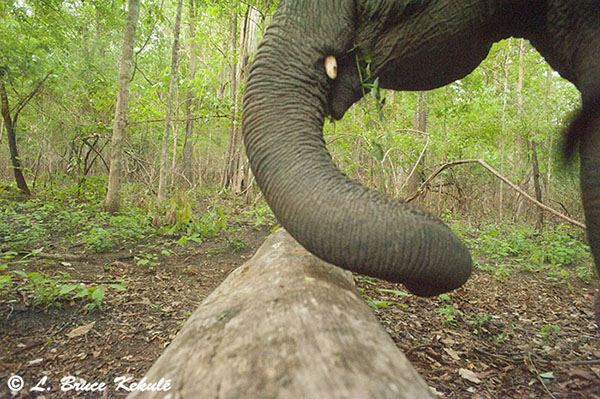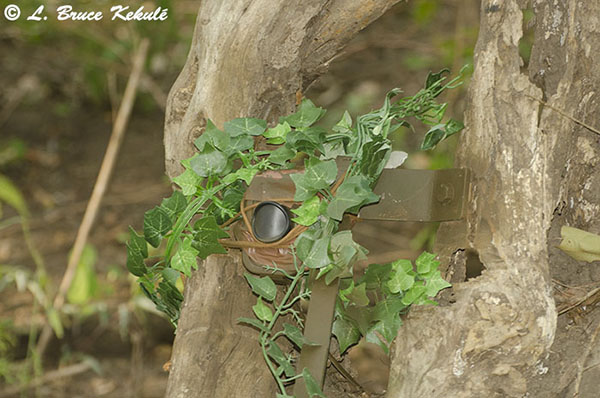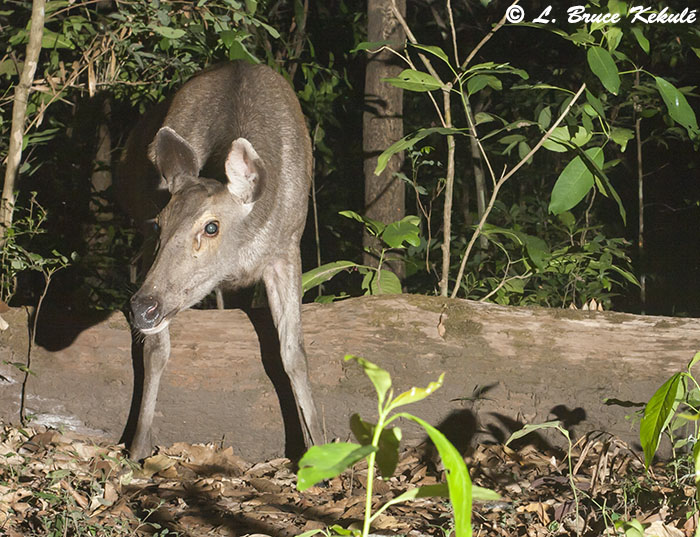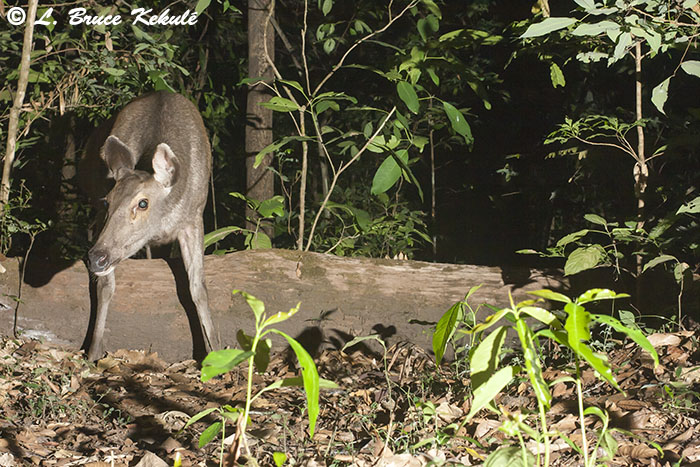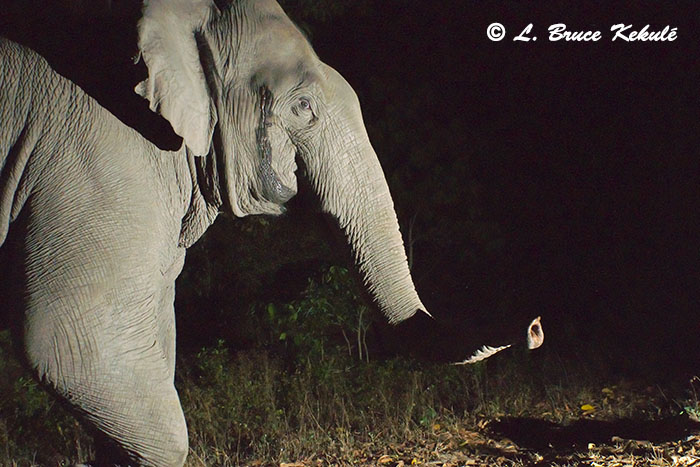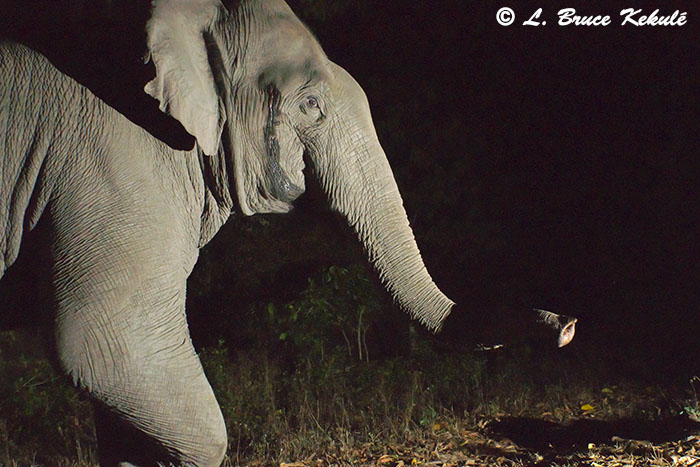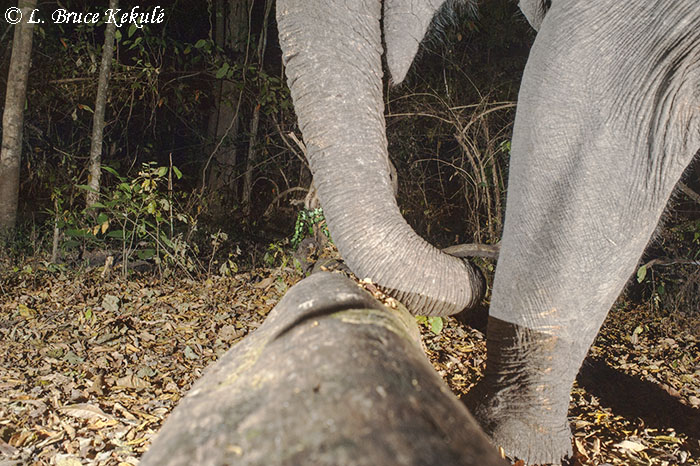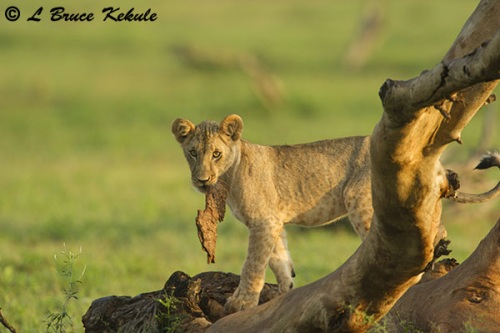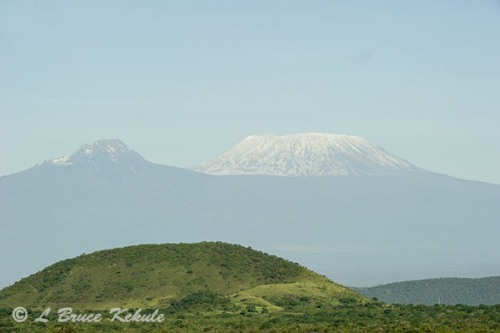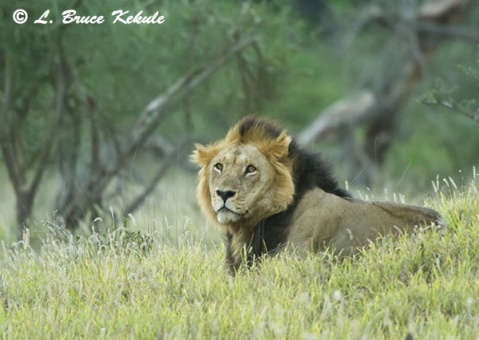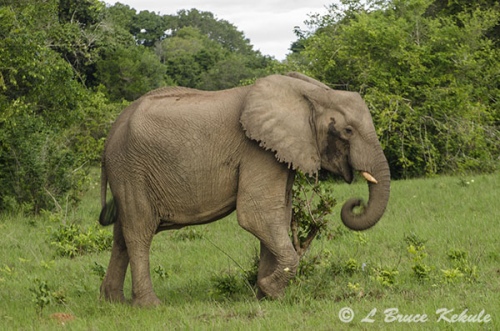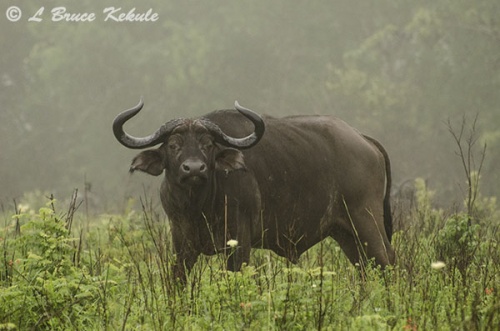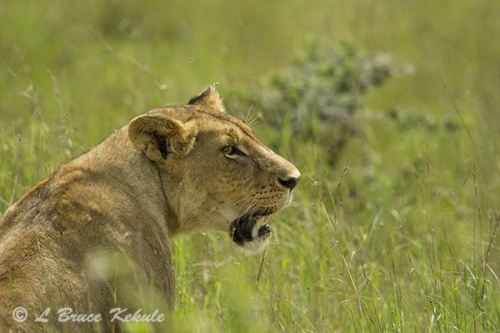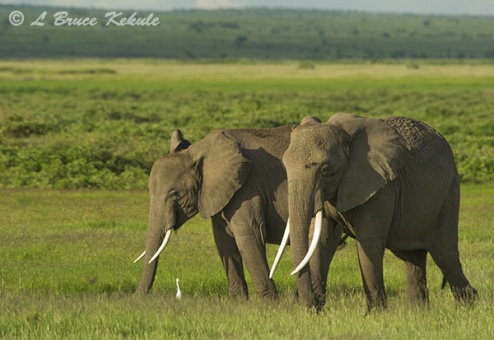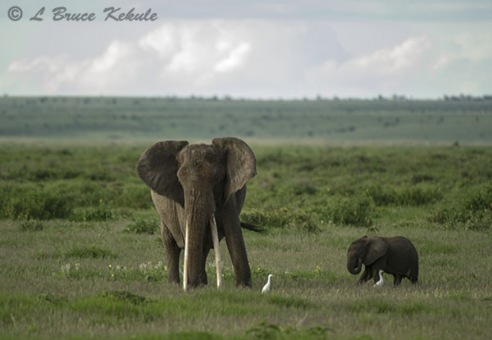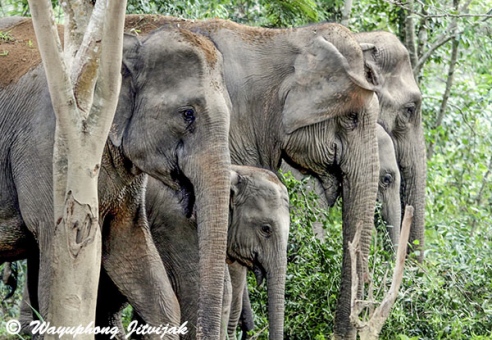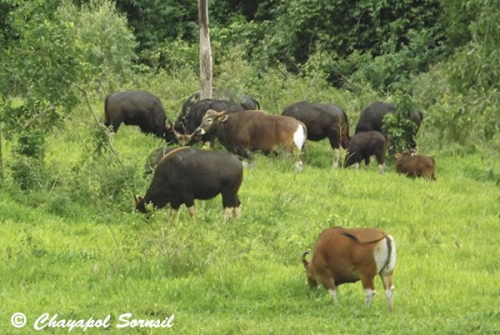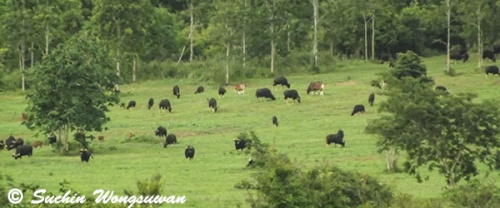Posts Tagged ‘elephant’
Flash Attack
Nikon D700 catches a male leopard on one paw…!
A big cat crossing the ‘tiger log’
Male leopard shot #1.
Male leopard on one paw….shot #2.
Male elephant – the flash destroyer.
Elephant back for more.
Banteng bull.
Evert year, forest fires occur in Thailand’s ‘Western Forest Complex’ during the dry season usually started by the human population living around the protected areas. Occasionally, lightning ignites fires but this natural phenomena, is less frequent. Stray cigarette butts also account for many fires. For the most part, local poachers start them to allow long distance spotlighting during the night. With the brush gone, they are able to see the reflection in the eyes distinctly (usually deer) with their headlamps.
Occasionally these fires are fierce and any camera trap left in the forest during this time will likely be destroyed. I always move my cams to evergreen forests from about February through to April that normally do not have fire, and this year was no different. But as soon as the first monsoon rains come in mid-April, the forest is safe once again for camera trapping.
With the first good rains through, I decided to setup my Nikon D700 back on the log. This time the cam is using a hardwired SSII sensor (Snapshotsniper.com) with a 10-meter cable setup in the tree stump apposite the cam. Also, a third flash was added and installed above the cam’s ‘elephant proof ‘ box. However, the ‘third flash’ is now history as a young tusker found it and turned it into rubble (below) but the cam, the sensor and two other flashes survived.
It was great to see this male leopard cross over the log. The first image is a good record shot but the second one is really something special catching this mature predator on one paw with the other three in mid-air. Also, the reproductive organ is sharp and just hanging there with its tail is balancing the big cat. He looks like he is winking at the cam. Once again, within two shots, the leopard turned his head to see what the flash was all about just like my tiger in late January 2014. The speed and reaction time of these felines is legendary and it doesn’t get any better…!
I also got the elephant that destroyed the third flash plus a banteng bull that stopped short but did not cross over. All in all, it was a great start to a new season at the ‘tiger log’. The full-frame D700 firing off a two-shot burst is in its element with a 28mm lens but now with only two flashes thanks to the forest giant. I have installed a 35mm lens this time to see what a tighter crop will do. Enjoy..!
Damaged SB-28 flash.
Nikon D700 setup on the log.
Hardwired external SSII (Snapshotsniper.com) sensor.
Hardwired Nikon SB-28 flash setup.
*****************************************
D700 settings: ƒ8 – 1/125 at ISO 400.
Edited in Adobe Camera Raw.
Leopard shot #1: full-frame.
Leopard shot #2: cropped.
Elephant and banteng bull: full-frame.
Sony A500 trail cam catches a wild elephant in ‘musth’
You never know what might show-up at a DSLR but when in elephant country, it’s pretty certain the big herbivore will pass the cam. However, this middle-aged wild male elephant was in a state of ‘musth’, a serious natural affliction. It would be a disaster if you bumped into this guy in the forest. Better to catch him with a trail cam…much safer..!
‘Musth’ is known to affect both wild and domestic elephants. It is an extremely dangerous time to be around one when it occurs characterized by highly aggressive behavior and accompanied by a large rise in reproductive hormones. A smelly liquid seeps from the temporal gland and sometimes into the mouth. These males have headaches causing severe pain. Needless to say, it was a great catch, something that is not documented to often, specially in the wild…! Enjoy..!!
Canon 400D DSLR catches an elephant’s trunk
A new location waiting on tiger…!
Elephant’s trunk right next to the SSII sensor hidden at the base of a tree.
It has taken awhile to get this trail cam working but it’s finally tripping well at a well-known tiger trail with plenty of battery life left in the cam and flashes after some two weeks in the field. This elephant was the first creature to cross in front of the external sensor set close to the log, and the Canon with two hard-wired SB-28s seems to be right on. I think the 400D with a Nikon 50mm ƒ1.4 manual lens looks perfect for tiger (settings: ISO 400 – ƒ8 @ 1/125). I have since added a third flash to help reduce any more shadows but that will have to wait till my next field trip next week. I look forward to checking this cam and evaluate if the third flash is really needed, and to readjust composition up a tad. Enjoy.
Canon 400D in an ‘elephant proof’ aluminum box with three Nikon SB-28 hard-wired flashes.
LBK testing the sensor and focus..!
Nikon D700 captures ‘big foot’
A wild elephant passing the log…!
Last month was a quiet one for my Nikon D700 trail cam…all I got was a big elephant going over the log…these are the two shots….I think the second one is unique and a bit abstract…!
The D700 is at a new location where I previously got tapir, tiger, gaur and elephant plus sambar and barking deer. Enjoy….more to follow.
The Big Five: Mega-fauna of the East African savanna
A safari to Kenya’s protected areas photographing the ‘Big Five’
Leopard mother in Samburu National Reserve
As we motored back to the lodge after my last game drive in Kenya’s Samburu National Reserve in December 2012, the feeling of disappointment began to overcome me. With no leopard in the bag, I would not get the so-called ‘Big Five’, which are the most dangerous animals on the African continent made up of elephant, rhino, buffalo, lion and leopard. Of these, it is the leopard that is the most notoriously difficult to obtain and is the secret to a successful safari.
My driver/guide Patrick Njoroge was more optimistic and said, we still had time and as if the ‘Spirits of the Wild’ were listening, a female leopard and her two cubs out in the morning sunshine, suddenly appeared by the side of the road. I immediately began shooting my Nikon medium camera, as they were very close. The action was quick and they then melted into the bush. After the dust settled, a feeling of joy took over me. My dream to get the ‘Big Five’ had come true once again.
In September 2010, I had a great opportunity to visit Kenya and on the very first day, got a leopard in a tree in the Masai Mara National Reserve that guaranteed the ‘Big Five’ was in the bag. I managed to get the other four quite easily.
Lion cub with a piece of bark in Tsavo East National Park
On my next safari in August 2011, a leopard was captured the second day, again in Masai Mara. A mother and her cub were hanging out in a dry streambed eating an antelope carcass. My driver/guide, the late George Ndungu managed to get the vehicle real close and I was able to photograph both of them. The elephant, buffalo, lion and finally the rhino were also collected.
On my third trip in May 2012 to southern Kenya while me and Patrick were out on game drive, he spotted a leopard kill (wild cat and jackal) in a tree by the side of the road. This was amazing in itself, and I decided to set a camera trap in a hollow log on the ground facing up at the kill. The next morning, I netted a single photo of the leopard with the jackal in its mouth. This was in Tsavo East National Park and that was a spooky capture.!
Getting the ‘Big Five’ a forth time in a row this last December was for me a complete stroke of luck. Many photographers and nature lovers who visit the ‘Dark Continent’ strive for the complete group but go home feeling empty-handed without the spotted cat. But then again, others bump into the ‘ghost’ easily. It is all about luck and I feel fortunate to have some, I guess.
Elephant bull in Tsavo West National Park
The term the ‘Big Five’ was coined by colonial hunters in East Africa sometime in the 1850s, and was the trophies collected of the large dangerous mammals all taken with a gun. Photography was in its infant stage and very few photographs of wild animals in the natural habitat were available from the era other than pictures of downed animals with the trophy hunter and gun bearers by its side.
Going on safari was big business just after the beginning of the 20th century, and usually only the well off could afford such a journey. It actually was quite fashionable to visit Africa and bag the ‘Big Five’. They then took the trophies home to show them off to other like-minded hunters.
The safari business was thriving and when many famous people like Theodore Roosevelt and later Hollywood movies stars like Clark Gable, Ava Gardner, Grace Kelly and Stewart Granger really made the business jump.
Cape buffalo bull in Amboseli National Park
But remember, Roosevelt as President helped establish an additional five national parks to the list that already included Yellowstone, Yosemite, Sequoia, General Grant, and Mount Rainier national parks. He doubled the number of national parks to 10 and helped numerous other protected lands get established.
One of the first countries to ban hunting in Africa was Kenya in 1977 whose people and government saw the need and meaning of saving wildlife for generations to come, and as a source of income for the country. Other countries like Tanzania followed suit and now one can go on a photography/viewing safari and see most of the animals that dot the savanna.
Protected areas were quickly designated and the business of safari continued, but because many animals have now come back from the brink of extinction, the efforts of the government has paid-off. Kenya and Tanzania are commended for taking the first brave steps in protecting the environment and its wildlife for the world to see and cherish.
Black rhino female in Nairobi National Park
I am of course addicted to Africa, especially Kenya. They say once you get the bug, it’s hard to stay away. I am planning another safari with my family sometime this year once again with Trans World Safaris in Nairobi. They have proven to be the best safari company for my needs. Their organization, planning and staff are superb.
In the event you take a vacation, I recommend a safari to Kenya. The chances are good that you will see many creatures of nature including the ‘Big Five’. Reasonable costs can be had with a little shopping on the Internet. The choices are broad and a ‘once in a lifetime’ trip is there for the taking. Enjoy!
The ‘Little Elephant Slider’
A 3-month old baby elephant slides in on the trail to a waterhole deep in the forests of western Thailand. This family unit is also made-up of several mature females and younger juveniles.
Africa’s Big Five: Three times lucky…..!
In 2010 and 2011, I was extremely lucky to visit Kenya in East Africa to photograph the ‘Big Five’ including elephant, white rhino, buffalo, lion and leopard plus many other species in several protected areas including the Masai Mara, Lake Nakuru and Samburu national reserves plus Sweetwaters private reserve in the west and central areas of Kenya.
Mt. Kilomanjaro seen from Amboseli National Park.
This year in May, it was decided with the safari company to go south this time to some new but very famous protected areas including Amboseli and Tsavo (West and East) national parks near Mount Kilomanjaro on the border with Tanzania. I also visited Shimba Hills and Taita wildlife sanctuaries and finally Nairobi National Park near the city of Nairobi.
Mt. Kilomanjaro seen from Tsavo (West) National Park.
The highlight of this trip was catching a black-mane lion in the grasslands of Taita Wildlife Sanctuary on my way back to Nairobi near the end of my trip. A very luck encounter and a dream come true….!
Black-mane lion in Taita close to dusk.
Lazy lion yawning and showing his canines.
Then I was also extremely lucky to catch an elusive black rhino mother and her calf in Nairobi National Park on the last day of the safari. They were reintroduced from South Africa. These massive beasts are tough to see let alone photograph…!
Black rhino mother and calf down in a gully.
Another shot of the pair higher up on the ridge.
In most of the parks in Kenya, elephant and buffalo are common and easy to see and photograph. However, in Tsavo National Park, the world’s largest protected area, both species are red from the earthen clay found here and they stand-out. I spent six days in both sections of Tsavo and it was an amazing adventure.
A bull elephant in Tsavo (West) National Park.
Another red bull in Tsavo (East) National Park.
A Cape buffalo bull in Tsavo (East).
Then, I headed further south to the mist shrouded jungles of Shimba Hills near the southern port city of Mombassa on the coast. Here elephant are gray and buffalo are black as normal with other parts of Kenya.
Young elephant in Shimba Hills. This bull is in musth, a state where male elephants can be very aggressive. Note fluid draining from the temporal gland.
A Cape buffalo bull with an unusual set of horns in mist shrouded Shimba Hills.
Over the course of two weeks, I traveled more than 3,000 kilometers with my good companion, driver and guide Patrick Mjoroge, a Kenyan national with a good heart and loads of experience (more than 25 years) to help me get the best possible opportunities for photographing wildlife. He is an ‘eagle eye’ and saw the wild cat and jackal hanging in a leopard’s tree in Tsavo (East).
Leopard’s prey: A wild cat and a black-backed jackal.
My leopard camera trapped eating the jackal in Tsavo (East).
This was simply an amazing feat which allowed me to camera trap the leopard previously published under ‘A needle in the haystack’ and to make-up the ‘Big Five’ once again. Three times lucky I guess.
Me and Patrick in Taita Wildlife Sanctuary.
I’m now in the process of planning a forth visit to Kenya in early December. It will be another two-week trip down south hopefully to catch some more species that I still do not have like kudu and wild dogs. I’m working on a forth book about wildlife in Asia and Africa as a comparison, and hope to be finished sometime next year. That’s the plan anyway..!
Hope ya’ all will enjoy this post. Another post to follow on all the other species I collected in the two-week period.
Additional photos of the ‘Big Five’:
Lone lioness found in the savannah during mid-day in Nairobi National Park.
Elephants in Amboseli National Park.
Cape buffalo in Amboseli.
Mother elephant and baby in Amboseli. These are the longest tusks I have ever seen on an African elephant. This place is well protected with a mandate of ‘shoot to kill’ any poachers.
Kuiburi National Park: Natural evolution in Southwest Thailand
Home to wild elephant and gaur:
Elephants and gaur just after a rain in the grassland
“Wild elephants should live here in the wild, but the forest must be restored to a state in which it is able to be a source of sufficient food. We must dedicate small plots of land throughout the forest that will serve as food sources. Moreover, elephants must be protected when roaming near the forest edge.”
His Majesty King Bhumibol Adulyadej on July 5, 1999 said on the management of the human-elephant conflict in Kuiburi National Park
A gaur bull in the grassland
Just about every afternoon, a natural phenomenon has evolved into one of Thailand’s greatest wildlife shows. A savannah or grassland situated in Kuiburi National Park in the southwest province of Prachuap Kirikhan provides a backdrop for sighting three of the Kingdom’s majestic wild animals.
Elephants, gaur and banteng seen in daylight are rare occurrences in other protected areas around the country but not here. Due to increased attention, conservation, research, funding and better protective enforcement management, the park is now world famous as a place to see these creatures. Even a tiger was recently seen here in broad daylight.
Asiatic jackal at one of eleven waterholes
This has taken place because many people now see the important aspect and value of protecting Thailand’s natural resources for the world to see. Conservation success stories are as rare as intact ecosystems and our precious wildlife. Kuiburi has become a role model for wildlife conservation in the nation.
His Majesty the King and Her Majesty Queen Sirikit have taken a special interest in Kuiburi from the early 1970s when Their Majesties provided assistance in the construction of the Yang Chum earthen irrigation dam in Kuiburi. Through their guidance in 1979, this Royal Project when completed provided access to 32 million cubic meters of water for the lowland people.
Elephant herd in late afternoon near a waterhole
After a big flood in 1996, the dam’s height was raised two meters with His Majesty providing funding to restrain more water. This was the first dam in Thailand that used earthen material from the United States to raise dam height. Water volume was increased another 9 million cubic meters and still operates to this day providing water for farming and subsidence to the people in the province.
His Majesty was also instrumental in coaxing villagers and farmers out of Kuiburi in the early 1990s, and in 1999 the protected area was finally established as a national park encompassing an area of 969 square kilometers. A large portion of the interior had already been cleared for agriculture with pineapples as the main crop plus sugar cane, vegetables, and several pine and eucalyptus tree plantations. Many people-elephant conflicts arose to become a serious problem for all. The degradation was quite severe but the park was saved just in the nick of time due to His Majesty’s efforts.
Elephant in a waterhole cooling off
Chalerm Yoovidhya of ‘Red Bull’ fame and owner of Siam Winery, has financed many projects improving the habitat for elephants and wild cattle. His first efforts were to develop firebreaks during drought periods and build check-dams in some streams to provide water in case of forest fire.
Another very important program implemented by his team and headed by Chayapol Sornsil has also improved salt licks and the grassland that attract these huge herbivores. Other programs like helping the rangers with food and equipment for patrolling has been undertaken. Chalerm recently started the ‘Thai Gaur Conservation Group’ based just outside the park. He is also organizing a foundation to help the infrastructure, up-keep of the grasslands and other important issues like the patrol rangers.
Banteng cow, mynhas and gaur in Kuiburi
Another important partner is the World Wildlife Fund (WWF) Thailand who has also been very busy with many projects in Kuiburi including helping the elephant-people conflict plus doing research and camera trapping in the interior to see what has survived the onslaught of poaching and encroachment over the years. Illegal hunting still goes on but now on a very limited scale. It is a tough one to stamp out completely but under proper guidance and supervision with ‘Outreach’ programs, there is a chance for zero poaching and no encroachment over the long run. They have also been involved in the grassland, salt lick and check-dam projects.
According to Dr Robert Steinmetz with WWF, there are five confirmed tigers and probably more, plus a multitude of other carnivores and prey species. Rare animals like tapir, Fea’s muntjac, clouded leopard plus Asiatic jackals, black bear, sun bear, golden cat among others has also been camera trapped by Robert. Wayuphong Jitvijak, also with WWF, has been extremely busy coordinating with the park’s personnel and local villagers on conservation, especially with the elephants.
Elephants in an old eucalyptus plantation
The most important aspect was the establishment of the grassland just a short four years ago that was compatible with wildlife. Huge areas of invasive Guinea grass (Megathyrsus maximus var maximus) that is not suitable to wildlife were removed, and replaced with Ruzi grass (Brachiaria ruziziensis), a species that elephants, gaur and banteng can live on and propagate. More than 12,000 Rai has been developed. Major funding from the National Lottery Bureau and grass seed from the Department of Livestock in conjunction with more funding from Siam Winery and WWF has been invested.
Another man has also been a very important asset for Kuiburi. He is Boonlue Pulnil, a former superintendent here who took a vested interest in the continued existence of the park. He managed to get funding to establish 11 waterholes that now provide water for the animals especially during drought periods. He still works for the Department of National Parks (DNP) and with several NGOs and groups on improving Kuiburi’s ecosystems and the wildlife. One such group is the Foundation for the King’s Wild Elephant.
Tiger photographed near the grassland in Kuiburi
Other people have taken an interest in Kuiburi’s long-term survival. The present chief of Kuiburi, Cholathorn Chamnankid is actively involved in improving protection and enforcement with a program of wildlife conservation and zero poaching. Other dignitaries include the Governor of Prachuap Khirikan, Weera Sriwathanatrakoon, who has been at the forefront of protecting Kuiburi. General Noppadol Wathanotai, advisor to His Majesty’s Projects, Office of the Principal Private Secretary is also working with the group. Kuiburi District Chief Officer Phongphan Wichiansamut, an avid nature fan, is supporting all activities on wildlife conservation and protecting the park for the future.
In July 2012, a MOU singing ceremony between the main agencies in Kuiburi including the Royal Thai Army (First Army Area of Thailand), Border Patrol Police Bureau and Provincial Police Operation Center made a dedicated effort in the province supporting the Tenasserim Agreement at Yang Chum Dam. These conservation results are positive showing a 100 percent increase in both populations of gaur and elephants. The grassland north of the headquarters is the key.
Mixed banteng and gaur herd in the savannah
Due to its status and improvement in awareness from near extinction to herds of about 250 elephants and more than 150 gaur, the road to recovery is positive. These amazing animals are now thriving very well, mainly around the savannah. Banteng however, is still highly endangered here with just a few individuals remaining including two mature bulls and one cow sighted mixing with gaur. It is hoped there are more banteng in the interior.
The need to protect these forests and wildlife in the lower Tenasserim Range is of vital importance. In the old days before roads, Kuiburi, Practakor reserved forest and Kaeng Krachan National Park to the north was all connected by naturally occurring corridor of thick rainforest along the border with Burma by these mountains.
Some 50 years ago, Thung Plai Ngam – a hunter’s paradise – was a favorite place of the rich to go on hunting trips. It is situated behind Pranburi reservoir but is now completely void of wildlife. Back then there were crocodiles in the river and large herds of elephant, rhino, gaur and tiger were common. Kuiburi was famous for its tigers in the old days.
The grassland success in Kuiburi National Park
As humans built roads and expanded into virgin forests after wood and other resources, agriculture and villages followed and replaced the jungle. All the classic Asian animals and ecosystems were systematically wiped out in man’s eager quest to survive. It is impossible to get all this back but it is imperative that the remaining patches of forest and wildlife must be saved and protected to the full extent of the law.
One of the most important aspects of wildlife conservation is to educate the people on the importance of saving Kuiburi for future generations and the world to see. Also, to keep any expansion in the park to an absolute minimum, and make sure the rangers undertake constant patrols, and arrest and put law-breakers behind bars for long periods of time. It is a fact! With zero poaching and no encroachment, the forest and wildlife will come back over time.
It now seems that Kuiburi is a special place in Thailand, and we all should be proud of the people who are or have been involved it its continued survival. They should be commended for their efforts. It has made the difference and the Kingdom’s natural heritage has recoved from near extinction to this. Finally, constant pressure must be applied to all aspects of protecting the Kuiburi forests so generations to come will see the heroes and successes of today..!





